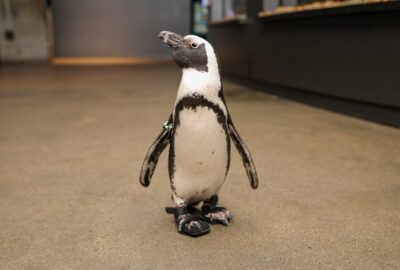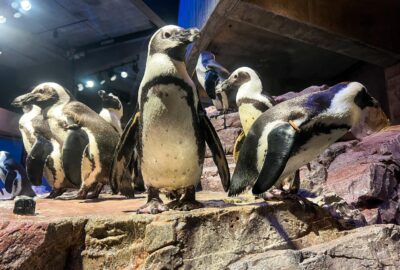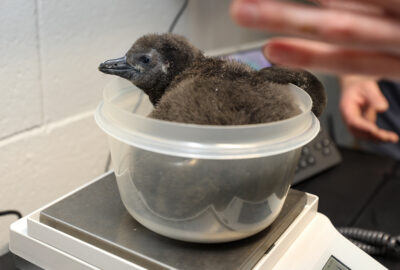Taking Care of the Oldest Penguins in Our Colony

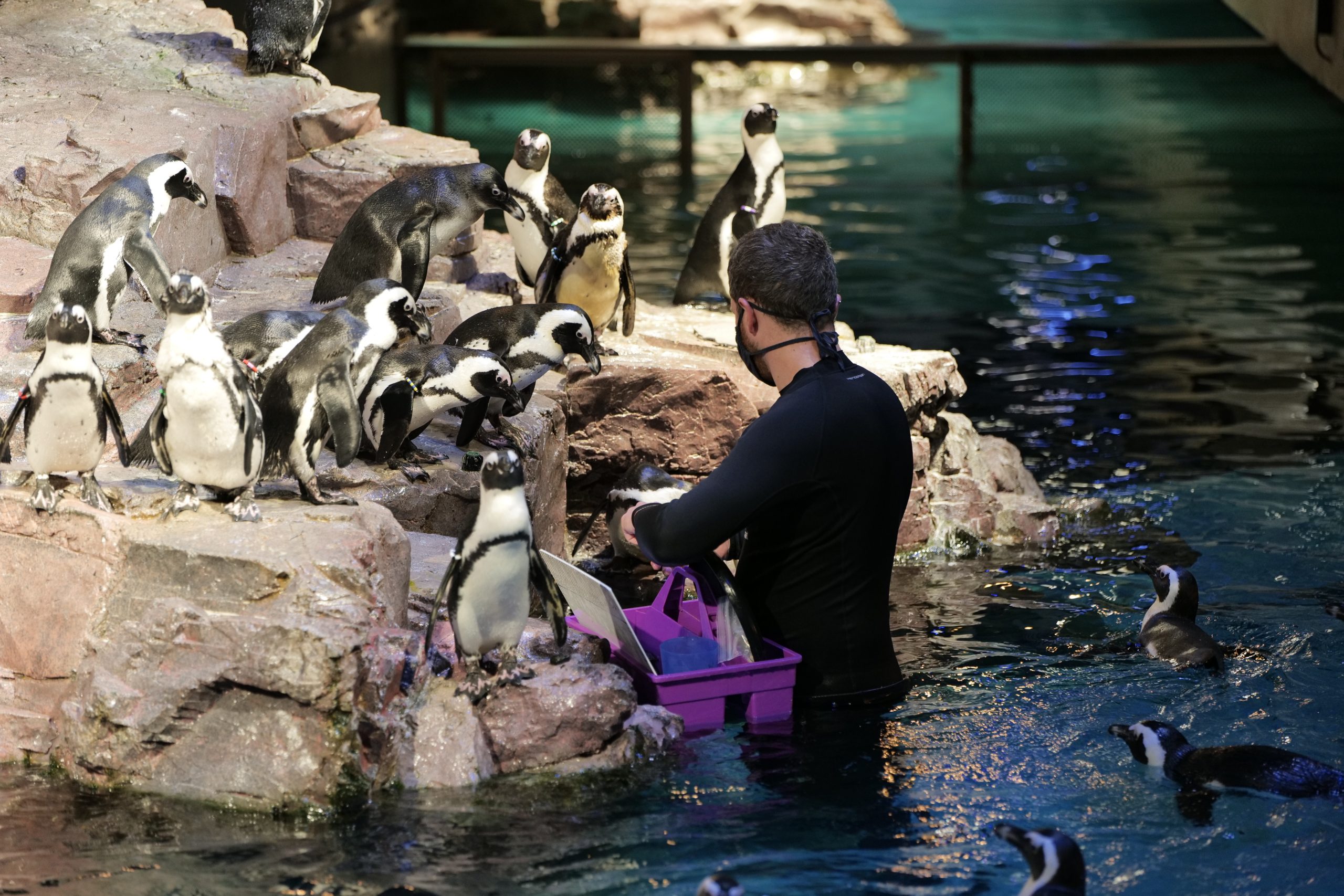
Seeing them darting around the water or hopping from rock to rock in their exhibit, it might be hard to believe that many of the penguins in the Aquarium’s care are older birds. But, as of this date, 27 out of 52 penguins across both the African penguin and Southern rockhopper populations have outlived their expected lifespan of 15 years—and several have gone far beyond it, reaching into their 20s, 30s, and even 40s. That adds up to 52 percent that are officially considered “geriatric,” a term that connotes animals of advanced age.
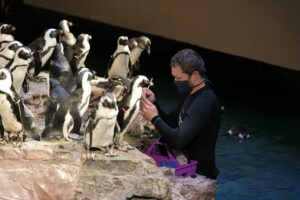
So, what does it take to keep an aging penguin population healthy and happy? A lot of collaboration, says Senior Penguin Trainer Amanda Barr. “We work very closely with the vet team, and we talk to them pretty much every day about somebody,” she said. That work involves everything from passing along which birds need special attention to working together on behavioral training to help administer appropriate treatments. These include feeding older penguins hydrated fish that’s been injected with extra water to promote kidney health, administering daily eye drops, applying foot treatments to prevent infections, and even doing acupuncture and physical therapy. “We work really closely together with [veterinarians] to make each decision as we’re changing management for any bird,” Amanda added.
Eric Fox, the penguin exhibit manager at the Aquarium, agreed. “It’s all about communicating,” he said, not just with the Veterinary team but with one another. Animal Care staff keep careful records on each penguin’s behavior, feeding records, and more, so everyone is enabled to spot changes that might be indicative of needing treatment. Animal Care and Veterinary team members also have weekly meetings to do rounds and discuss any concerns.
Relationships between the Animal Care staff and the penguins are just as important as the ones between colleagues. Eric and the team have worked hard to incorporate trainings into the penguins’ care to acclimate them to being handled and help them participate in their care. For example, each penguin is trained to approach a staff member for feeding and to hop up onto the rocks in the exhibit to receive their meal. “When they’re up there on land, we can do physical checks on every part of their body,” said Eric. “We’re looking at their face, their beak, their eyes,” and more, making sure each penguin looks healthy and is behaving normally.
Knowing what that “normal” behavior is means paying careful attention to each of the 52 penguins in the Aquarium and getting to know them as individuals. “It might be totally common for Deco (the oldest penguin at the Aquarium) to be one of the last ones to feed,” said Eric. “But if it’s another bird, that might be one of our first signs.”
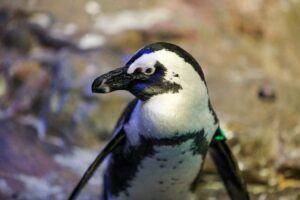
Along with keeping a close eye on the penguins daily, the team performs more formal quarterly health checks on the colony. During these exams, they’re keeping an eye out for common ailments that afflict older penguins, including foot injuries and cataracts, as well as checking each penguin’s weight.
Kristen Van Oss, curator of penguins and pinnipeds at the Aquarium, says this proactive approach is key. “We know these birds are beyond their [expected] age, and we know that we’re going to have to chronically treat them long-term.” Each step the team takes helps better ensure every bird’s well-being. The high level of care each penguin receives reflects the Aquarium’s broader goals to enhance the lives of the animals cared for and to ensure their physical, mental, and emotional health.
“Getting the chance to work with vulnerable or endangered animals is not something everyone gets to do,” said Eric. Being able to share their successes with other institutions and apply what the team has learned to penguins in their native environments is helping further penguin conservation beyond the Aquarium, too. “If you think about that, from a global perspective, it’s amazing what we’ve been able to partake in,” Eric added.
So, next time you see one of the Aquarium’s penguins swim over to their trainer for a meal, you’ll know there’s a lot more going on than just lunchtime—and that work helps keep them living longer.
Meet a few of our oldest penguins, and learn more about the specialized care they’ve received:
Lambert
At 30, Lambert is the fifth-oldest penguin in the African penguin colony. He hatched here at the Aquarium on April 20, 1992. Lambert underwent double cataract surgery in 2019 to improve his eyesight, and today he receives daily eye drops. He’s also gotten a melatonin implant to help with an overdue molt, a common condition that also affects wild penguins. Watch our video from one of Lambert’s check-ups and learn more!
Deco
Deco celebrated her 41st hatch day in August 2022 and is not only the Aquarium’s oldest penguin—she’s the oldest penguin in the Association of Zoos and Aquariums. Deco also has one chick, “Good Hope,” who is 33 years old and also lives at the Aquarium. Deco receives hydrated fish and a joint supplement daily, as does her chick, Good Hope!
Updated October 19, 2023
In addition to being the oldest penguin in the AZA, Deco was also the oldest penguin we had ever cared for at the Aquarium. She passed away during the summer of 2023, just 1.5 months shy of 42 years old, but her legacy will live on in our African penguin colony.
As part of the AZA African Penguin Species Survival Plan, which supports conservation efforts and thoughtful breeding for a sustainable future for penguins like Deco, Deco had one chick. That led to 6 grand chicks and 12 great-grandchicks, including our newest African penguin chick, Bray. It is safe to say our penguin colony would not be what it is today without her!
We were fortunate to care for Deco for so many years.
Pomona
Pomona’s needs are a bit different than some of his fellow elder penguins. As a chick, in some of his first days of life, Pomona developed an infection that caused the loss of one eye. So, it’s very important to make sure his good eye stays healthy! He received behavioral training, so he’s well-acclimated to receive daily eye drops, and the team keeps an especially close watch for any signs of trouble in his working eye. “If he’s even squinting, we jump on it,” Eric said.
Harlequin
2022 marks Harlequin’s 30th hatch day. She and her mate, Durban, have been paired together since 2000 and have raised eight chicks together. Harlequin has received foot treatments on exhibit, and the team continues to do training sessions with her to keep her used to being handled and having her feet touched. If she needs further treatments on her feet in the future, she’ll be well prepared for them!

